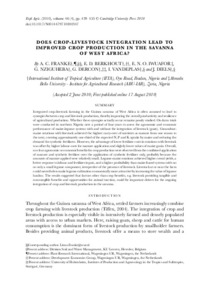| dc.contributor.author | Franke, A.C. |
| dc.contributor.author | Berkhout, E.D. |
| dc.contributor.author | Iwuafor, E.N.O. |
| dc.contributor.author | Nziguheba, Generose |
| dc.contributor.author | Dercon, G. |
| dc.contributor.author | Vandeplas, I. |
| dc.contributor.author | Diels, J. |
| dc.date.accessioned | 2019-12-04T11:14:00Z |
| dc.date.available | 2019-12-04T11:14:00Z |
| dc.date.issued | 2010-08 |
| dc.identifier.citation | Franke, A.C., Berkhout, E.D., Iwuafor, E.N.O., Nziguheba, G., Dercon, G., Vandeplas, I. & Diels, J. (2010). Does crop-livestock integration lead to improved crop production in the savanna of West Africa? Experimental Agriculture, 46(4), 439-455. |
| dc.identifier.issn | 0014-4797 |
| dc.identifier.uri | https://hdl.handle.net/20.500.12478/2603 |
| dc.description.abstract | Integrated crop-livestock farming in the Guinea savanna of West Africa is often assumed to lead to synergies between crop and livestock production, thereby improving the overall productivity and resilience of agricultural production. Whether these synergies actually occur remains poorly studied. On-farm trials were conducted in northern Nigeria over a period of four years to assess the agronomic and economic performance of maize-legume systems with and without the integration of livestock (goats). Groundnut-maize rotations with livestock achieved the highest carry-over of nutrients as manure from one season to the next, covering approximately one-third of the expected N, P and K uptake by maize and reducing the demand for synthetic fertilizers. However, the advantage of lower fertilizer costs in rotations with livestock was offset by higher labour costs for manure application and slightly lower values of maize grain. Overall, no clear agronomic or economic benefits for crop production were observed from the combined application of manure and synthetic fertilizer over the application of synthetic fertilizer only, probably because the amounts of manure applied were relatively small. Legume-maize rotations achieved higher cereal yields, a better response to labour and fertilizer inputs, and a higher profitability than maize-based systems with no or only a small legume component, irrespective of the presence of livestock. Livestock at or near the farm could nevertheless make legume cultivation economically more attractive by increasing the value of legume haulms. The results suggested that factors other than crop benefits, e.g. livestock providing tangible and non-tangible benefits and opportunities for animal traction, could be important drivers for the ongoing integration of crop and livestock production in the savanna. |
| dc.format.extent | 439-455 |
| dc.language.iso | en |
| dc.subject | Livestock Farms |
| dc.subject | Farming Systems |
| dc.subject | Crop Production |
| dc.subject | Agricultural Production |
| dc.title | Does crop-livestock integration lead to improved crop production in the savanna of West Africa? |
| dc.type | Journal Article |
| dc.description.version | Peer Review |
| cg.contributor.affiliation | International Institute of Tropical Agriculture |
| cg.contributor.affiliation | Ahmadu Bello University |
| cg.coverage.region | Africa |
| cg.coverage.region | West Africa |
| cg.coverage.country | Nigeria |
| cg.coverage.country | Guinea |
| cg.isijournal | ISI Journal |
| cg.authorship.types | CGIAR and developing country institute |
| cg.iitasubject | Crop Husbandry |
| cg.iitasubject | Farming Systems |
| cg.iitasubject | Plant Production |
| cg.journal | Experimental Agriculture |
| cg.howpublished | Formally Published |
| cg.accessibilitystatus | Limited Access |
| local.dspaceid | 93407 |
| cg.targetaudience | Scientists |

